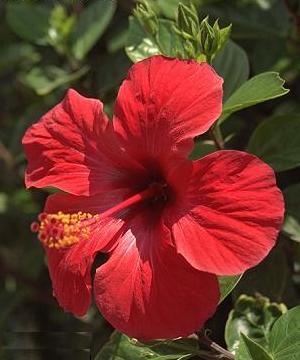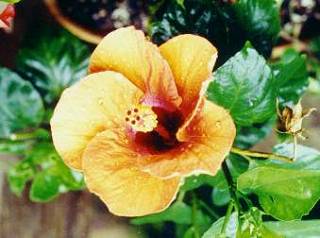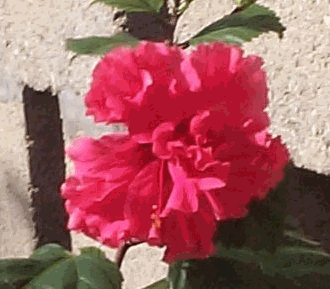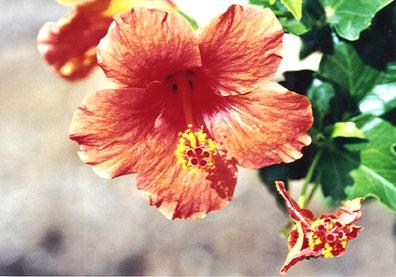|
Plants
for your home
(By Mary Efanti)
Hibiscus "Rosa Sinensis"
 Origin and
Description Origin and
Description
"Chinese
hibiscus" are among the most showy flowers of the tropics. The geographical
origin of Hibiscus rosa-sinensis, which literally means "Rose of China"
is obscure. Some early references claim it is a native of China. Hibiscus forms
grown in that country, some of which eventually found their way to Europe.
Others suggest the species was cradled in India.
Early botanists suggest Polynesian migrants may have brought Hibiscus with them
from South-East Asia. And so to Hawaii, Tahiti and Fiji. These exotic places
feature them in many areas of life. Hibiscus became the national floral emblem
of Hawaii. Earlier crossing of Chinese and native Hawaiian Hibiscus species has
given rise to the development of most of the thousands of hybrids grown today.
The original tropical hibiscus had a red flower, but breeders have produced a
wild variety of colors including tricolors of pink, orange and yellow,. Recently,
many hybrid polyploid plants with multicolor or double blooms have been
developed. Chinese hibiscus, Hibiscus rosa-sinensis, is a beautiful, easy-to-care-for interior
plant. It is closely related to Hibiscus syriacus,
Rose of Sharon or Shrub Althea, which is grown outdoors. Chinese hibiscus,
however, is not winter hardy.
Care
 Position Position
Many people use Chinese
hibiscus as a patio plant in the summer as it will grow in full sun, but keeping
a hibiscus outdoors for part of the year creates some special problems with its
care. The leaves that develop outside in full sun are quite different from
leaves that develop indoors, so don't be surprised when the leaves of your
hibiscus turn yellow and drop off in the fall after you bring the plant inside.
Leaves on an indoor hibiscus will be larger, darker green and thinner than
leaves on a hibiscus that spends its summers outdoors.
Find the brightest window in
your home to keep your hibiscus happy; usually this will be a south or west
window. Place it as close to the window as possible but keep the leaves from
touching the glass. Turn the plant weekly to encourage uniform growth.
 Pest Control Pest Control
Keep your hibiscus clean to
reduce the chance of insects making a home there. If it is a manageable size,
put it in the shower and give a good bath every couple of months. Always clean
plants and pots thoroughly before bringing into the house. Insecticidal soap may
be used on hibiscus to treat insect infestations; use precautions and follow all
label instructions.
Watering
A healthy, growing hibiscus
will use a lot of water. Use your fingers to check the soil moisture and water
thoroughly when the soil dries out. Water should drain freely from the bottom of
the pot, but do not let the plant sit in water. If your hibiscus is outside
during the summer, it will need to be watered every day. Interior plants will
need to be watered weekly during active growth periods, less often during the
cooler winter months. Leaves will wilt, yellow and drop off if the soil dries
out completely.
 Feeding Feeding
Hibiscus need a lot of
fertilizer during spring and summer to promote healthy leaves, but too much
nitrogen will keep it from flowering. Use 10-10-10 or a similar fertilizer
monthly from March to October. Hibiscus should flower all summer and fall; many
plants will flower year round if the conditions are right.
Pruning
Hibiscus is a vigorously
growing plant that will require annual pruning to maintain its shape and keep
the plant within the bounds of your home. Prune in early spring when the new
growth is beginning. Tree-form hibiscus need to have the lower sprouts removed
from the trunk and the top will need to be shaped. Shrub-form hibiscus will also
need to be shaped to remove excess legginess. Cut each branch back by
approximately 1/3 to 2/3 of its length; be careful to make your cuts at an
outward facing bud so the new growth will grow out away from the trunk and not
towards the center of the plant.
With proper care your hibiscus
should reward you with prolific flowering throughout the summer and fall.
Mary Efanti
[email protected]
|
